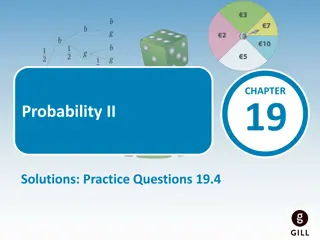Understanding Probability Tables and Venn Diagrams
Probability tables serve as alternatives to Venn diagrams for visually representing probability problems. This summary explains their use, significance, and practical examples illustrating their application.
Download Presentation

Please find below an Image/Link to download the presentation.
The content on the website is provided AS IS for your information and personal use only. It may not be sold, licensed, or shared on other websites without obtaining consent from the author. Download presentation by click this link. If you encounter any issues during the download, it is possible that the publisher has removed the file from their server.
E N D
Presentation Transcript
A probability table A probability table is an alternative to a Venn diagram when illustrating a probability problem diagrammatically. Consider the Venn diagram which illustrates two intersecting sets ? and ?. From the Venn diagram it can be seen that the sample space is divided by the sets into four disjoint regions: ? ?, ? ? , ? ? and ? ? . These regions may be represented in a table as follows. Such a table is sometimes referred to as a Karnaugh map.
From the Venn diagram it can be seen that the sample space is divided by the sets into four disjoint regions: ? ?, ? ? , ? ? and ? ? . These regions may be represented in a table as follows. Such a table is sometimes referred to as a Karnaugh map. A probability table
A probability table In a probability table, the entries give the probabilities of each of these events occurring. ?=(? ?) (? ? ) The sets ? ? and ? ? are mutually exclusive, so Pr(? ?)+Pr(? ? )=Pr(?) (row 1) and thus summing the probabilities in row 1 gives Pr(?). Similarly: Pr(? ?)+ Pr(? ? )= Pr(? )(row 2) Pr(? ?)+ Pr(? ?) =Pr(?) (column 1) Pr(? ? )+ Pr(? ? )=Pr(? )(column 2) Finally, since Pr(?)+Pr(? )=1 and Pr(?)+Pr(? )=1, the totals for both column 3 and row 3 are equal to 1.
If ? and ? are events such that Pr(?)=0.7, Pr(? ?)=0.4 and Pr(? ?)=0.2, find: Example 1. Pr(? ? ) 2. Pr(?) 3. Pr(? ? ) 4. Pr(? ?) 1. From row 1: Pr(? ? )=Pr(?) Pr(? ?)=0.7 0.4=0.3 2. From column 1: Pr(?)=Pr(? ?)+Pr(? ?)=0.4+0.2=0.6 3. From column 3: Pr(? )=1 Pr(?)=1 0.7=0.3 4. From row 2: Pr(? ? )=0.3 0.2=0.1 Using the addition rule: Pr(? ?)=Pr(?)+Pr(?) Pr(? ?)=0.7+0.6 0.4=0.9 The completed table is shown.
Example Records indicate that, in Australia, 65% of secondary students participate in sport, and 71% of secondary students are Australian by birth. They also show that 53% of students are Australian by birth and participate in sport. Use this information to find: 1. the probability that a student selected at random is not Australian by birth 2. the probability that a student selected at random is not Australian by birth and does not participate in sport. We use ? to represent Australian by birth and ? to represent participates in sport . All the empty cells in the table may now be filled in by subtraction. In column 1: Pr(? ?)=0.65 0.53=0.12 In column 3: Pr(? )=1 0.71=0.29 In row 1: Pr(? ? )=0.71 0.53=0.18 In row 3: Pr(? )=1 0.65=0.35 In row 2: Pr(? ? )=0.29 0.12=0.17 The probability that a student selected at random is not Australian by birth is given by Pr(? )=0.29. The probability that a student selected at random is not Australian by birth and does not participate in sport is given by Pr(? ? )=0.17.























